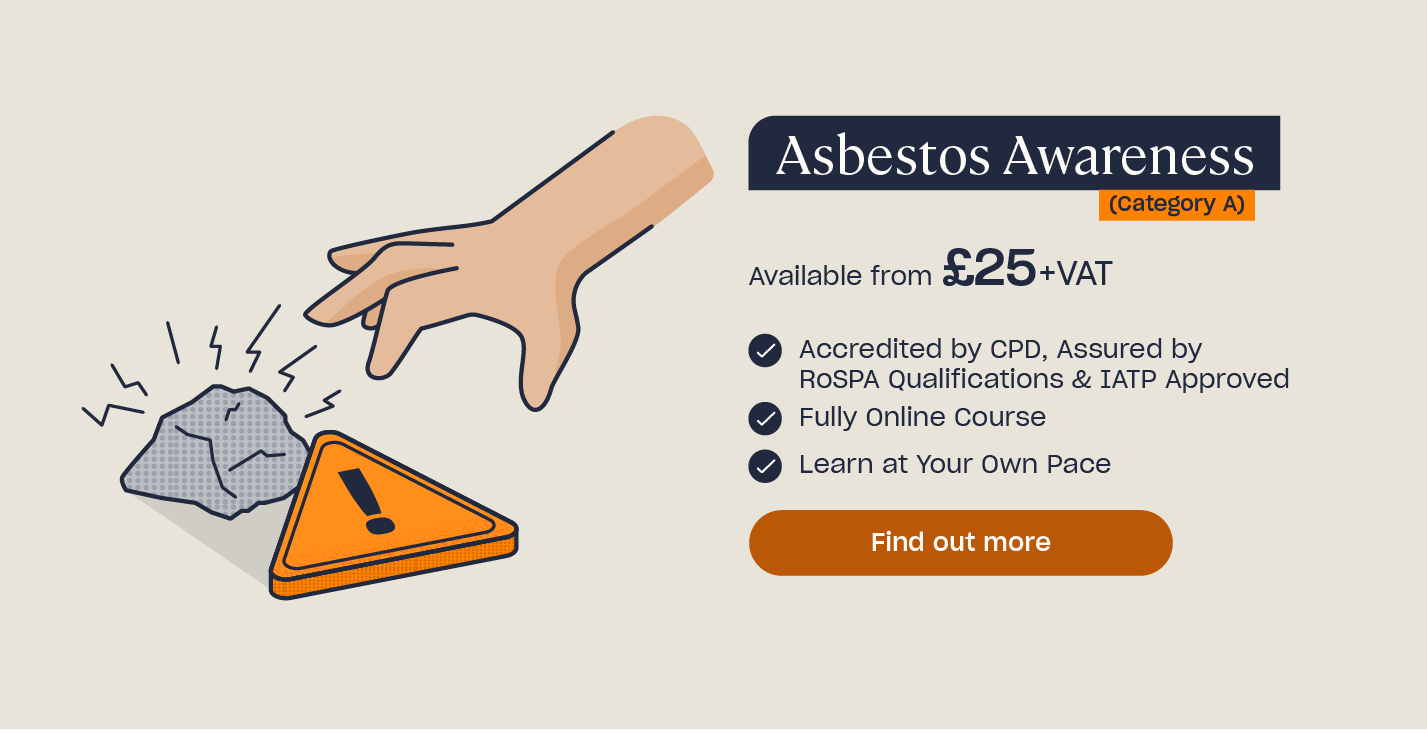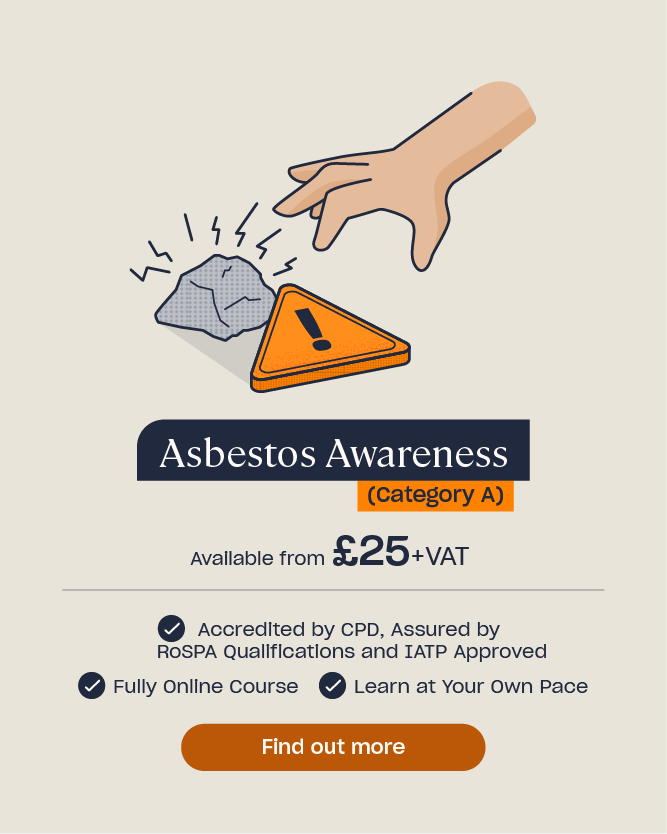What is Asbestos Awareness Training & Who Needs it?
Asbestos is a naturally occurring substance that has been used in buildings and materials to provide insulation and additional fire protection. However, asbestos was fully banned for use in the UK in 1999 due to it being extremely hazardous to health. Statistics published by the Health and Safety Executive (HSE) state that asbestos is responsible for over 5,000 deaths every year. All asbestos-related diseases typically take many years to develop, but can result in mesothelioma, lung cancer and other non-malignant diseases.
To ensure the health and wellbeing of yourself and those who may be present, you must understand where you may encounter asbestos. It is also important that you know what to do if you disturb asbestos. This is a possibility for many occupations, such as for construction workers or landlords.
There are three different types of asbestos training available: Asbestos Awareness Training (Category A), Non-Licensed Asbestos Training (Category B), and Licensed Asbestos Work (Category C). This article will explain what the first type, Asbestos Awareness Training (Category A), covers, why it is beneficial and who needs to take it.
What Should Asbestos Awareness Training Cover?
Asbestos awareness training is suitable for anyone who may encounter asbestos as part of their job, but are not required to work with asbestos or conduct asbestos removal. Although they do not work with asbestos-containing materials, they may still be exposed to risks. It is the lowest level of asbestos training and is intended to train people in what these risks are, and how to avoid them and disturbing asbestos. It provides learners with the basic knowledge and skills needed to keep themselves and others safe from asbestos.
The HSE provides information regarding what the law requires for asbestos training content in order for professionals to gain the required level of knowledge.
For asbestos awareness training, information, instruction and training should cover:
- The properties of asbestos and how to recognise it.
- The ill-health effects asbestos exposure can have on health. This includes the increased risk of developing lung cancer for workers who smoke.
- The types, uses and likely occurrence of asbestos and asbestos materials in both buildings and plant.
- How to avoid the risk of exposure to asbestos by following the control measures that are in place to manage this.
- The general procedures that you must follow to deal with an emergency. For example, in response to an uncontrolled release of asbestos dust into the workplace.

Online Asbestos Awareness Training
The HSE recognises that online learning is a popular method of providing asbestos awareness training. It must meet the requirements of Regulation 10 of the Control of Asbestos Regulations 2012 and the supporting Approved Code of Practice L143 ‘Managing and working with asbestos’. This is a legal requirement that we will explain in more detail later in this article.
Need Asbestos Awareness Training?
High Speed Training provides an online Asbestos Awareness Training (Category A) training course that is CPD accredited and approved by the The Royal Society for the Prevention of Accidents (RoSPA) and Independent Asbestos Training Providers (IATP) approved. You can find out more about it by visiting our website.
Different job roles will require a different level of asbestos training. If you require more information on this, you can consult our dedicated article, ‘What Are The Three Types of Asbestos Training?’. You may want to learn more about what asbestos actually is, in which case our ‘What is Asbestos?’ article may be useful.
Is it a Legal Requirement?
The relevant level of asbestos training is a legal requirement under Regulation 10 of the Control of Asbestos Regulations 2012. Specifically, this regulation states that “Every employer must ensure that [their] employee[s] are given adequate information, instruction and training where that employee is, or is liable to be, exposed to asbestos, or if that employee supervises such employees.”
This will ensure that employees can carry out their work effectively and safely. Employers have a legal duty to consider which type of asbestos training is suitable for their employees to meet the requirement of providing ‘adequate’ training.
Specifically, Asbestos Awareness (Category A) training is a legal requirement for anyone who may encounter asbestos but is not required to work with it. For example, it is suitable and a requirement for an employee who needs to avoid work that may disturb asbestos during any normal work. This may be because the fabric of a building is being worked on, or other items which might contain asbestos.
Some job roles which may require asbestos awareness training include:
- Construction workers.
- Demolition workers.
- Roofers.
- Plasterers.
- Heating engineers.
- Ventilation engineers.
- Carpenters and joiners.
- Plumbers.
This list is not exhaustive. It is your employer’s duty to assess the risks that employees will be exposed to, including those posed by asbestos, and to plan the appropriate level of training accordingly.
If workers are going to be carrying out work which will deliberately disturb asbestos, then they require a higher level of information, instruction and training, in addition to asbestos awareness. If this is the case, employers may wish to consult the HSE’s website for further guidance to ensure they meet their legal requirements under the Control of Asbestos Regulations 2012.

Who Do the Control of Asbestos Regulations 2012 Apply to?
The Control of Asbestos Regulations 2012 are the main regulations concerned with the prevention and control of exposure to asbestos. There are two main sets of dutyholders who are responsible for complying with the Regulations.
Firstly, the Regulations apply to anyone who is responsible for the maintenance and repairs of non-domestic premises, such as buildings and other structures and their surroundings. This applies to building owners themselves, and to those responsible for buildings or parts of buildings, whether or not they have a contract.
In addition, employers are also considered dutyholders who have a legal duty under the Regulations if they oversee any work which is liable to expose their employees to asbestos.
Employers must identify the presence of asbestos and carry out a risk assessment that outlines the control measures needed to manage asbestos exposure. They must also draw up a written plan of work for any work that involves asbestos, such as maintenance to the fabric of a building, before the work commences.

Benefits of Asbestos Awareness Training
From a health and safety perspective, asbestos awareness training is incredibly important for employees to have. Asbestos is extremely hazardous to health, with historic exposure to airborne asbestos fibres being the single largest cause of death to workers in the UK. This accounts for an estimated 5,000 deaths a year in the UK due to past exposure.
Asbestos exposure is often not immediately harmful to health. The onset of an asbestos-related disease, such as lung cancer, tends to occur between 15 to 60 years after the initial exposure to fibres. This means that workers may not notice the damage that asbestos fibres are causing to their health until it is too late.
Asbestos awareness training is beneficial because it makes workers aware of the severity of the risks posed by asbestos. It provides the knowledge and skills needed to work in a safe manner to avoid disturbing asbestos, and explains how to deal with asbestos-related emergencies, should they occur. This will help to ensure you keep yourself and others safe from potential asbestos exposure.
You should now understand more about the lowest level of asbestos training, asbestos awareness (Category A) and why it is important for employers to ensure that their employees have the required information, instruction and training. As well as being a legal requirement under the Control of Asbestos Regulations 2012, asbestos awareness training will help you to work safely to avoid the serious risk and long-term health consequences of asbestos exposure to yourself and others in the workplace.
Further Resources:
- Can You Remove Asbestos Yourself?
- Answering Your Asbestos Questions
- What to Do After Recent Exposure to Asbestos
- Asbestos Colours: What is the Most Dangerous Asbestos Colour?
- What is Gypsum in Construction?
- Asbestos Quiz








